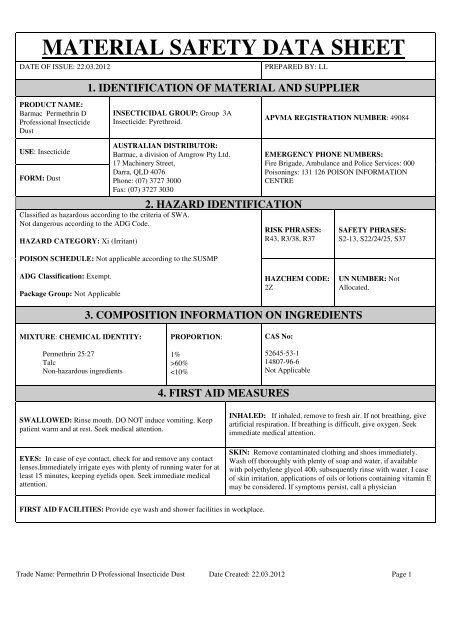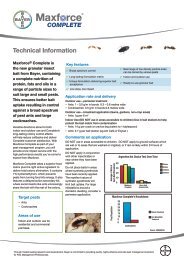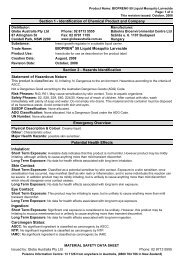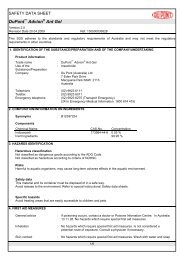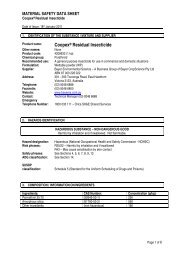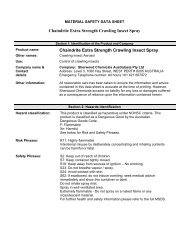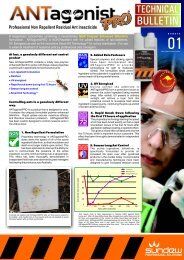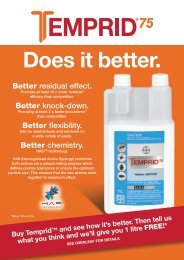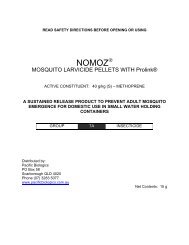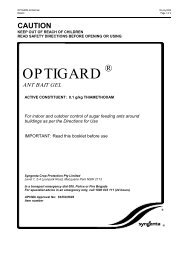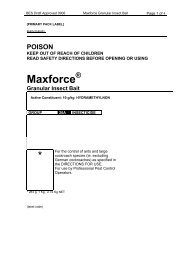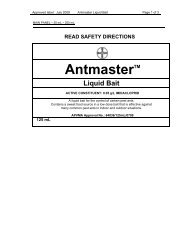MSDS - Corporate Pest Management
MSDS - Corporate Pest Management
MSDS - Corporate Pest Management
Create successful ePaper yourself
Turn your PDF publications into a flip-book with our unique Google optimized e-Paper software.
MATERIAL SAFETY DATA SHEET<br />
DATE OF ISSUE: 22.03.2012<br />
PREPARED BY: LL<br />
1. IDENTIFICATION OF MATERIAL AND SUPPLIER<br />
PRODUCT NAME:<br />
Barmac Permethrin D<br />
Professional Insecticide<br />
Dust<br />
INSECTICIDAL GROUP: Group 3A<br />
Insecticide: Pyrethroid.<br />
APVMA REGISTRATION NUMBER: 49084<br />
USE: Insecticide<br />
FORM: Dust<br />
AUSTRALIAN DISTRIBUTOR:<br />
Barmac, a division of Amgrow Pty Ltd.<br />
17 Machinery Street,<br />
Darra, QLD 4076<br />
Phone: (07) 3727 3000<br />
Fax: (07) 3727 3030<br />
2. HAZARD IDENTIFICATION<br />
Classified as hazardous according to the criteria of SWA.<br />
Not dangerous according to the ADG Code.<br />
HAZARD CATEGORY: Xi (Irritant)<br />
POISON SCHEDULE: Not applicable according to the SUSMP<br />
EMERGENCY PHONE NUMBERS:<br />
Fire Brigade, Ambulance and Police Services: 000<br />
Poisonings: 131 126 POISON INFORMATION<br />
CENTRE<br />
RISK PHRASES:<br />
R43, R3/38, R37<br />
SAFETY PHRASES:<br />
S2-13, S22/24/25, S37<br />
ADG Classification: Exempt.<br />
Package Group: Not Applicable<br />
HAZCHEM CODE:<br />
2Z<br />
UN NUMBER: Not<br />
Allocated.<br />
3. COMPOSITION INFORMATION ON INGREDIENTS<br />
MIXTURE: CHEMICAL IDENTITY:<br />
Permethrin 25:27<br />
Talc<br />
Non-hazardous ingredients<br />
PROPORTION:<br />
1%<br />
>60%<br />
5. HEALTH EFFECTS<br />
INGESTION: Low oral toxicity.<br />
EYES: May irritate eyes.<br />
SKIN: May irritate skin.<br />
INHALED: Inhalation of dust may cause respiratory irritation.<br />
CHRONIC: The following symptoms may occur: Prolonged and repeated contact with skin, eyes or mucous membranes may cause<br />
irritation. Burning sensation, cough, sneezing, respiratory disorder, pulmonary oedema, nausea, vomiting, diarrhoea, abdominal pain,<br />
salivation, dizziness, blurred vision, headache, anorexia, somnolence, coma, seizures, convulsions, tremors, ataxia, and muscular<br />
fasciculation.<br />
6. FIRE-FIGHTING MEASURES<br />
UNUSUAL FIRE & EXPLOSION HAZARDS:<br />
In the event of fire decomposition products such as hydrogen<br />
chloride, carbon monoxide and carbon dioxide can be released.<br />
SPECIAL FIRE FIGHTING PROCEDURES:<br />
Must wear suitable breathing apparatus and protective suit when<br />
fighting fire. Approach upwind.<br />
FLAMMABILITY: Flammable<br />
HAZCHEM CODE: 2Z<br />
EXPOSURE LIMITS:<br />
ASCC has set the an exposure standard for talc as TWA 2.5 mg/m³<br />
EXTINGUISHING MEDIA:<br />
Foam, dry powder and water spray.<br />
7. ACCIDENTAL RELEASE MEASURES<br />
PERSONAL PROTECTION: Use personal protective equipment. Avoid contact with spilled product or contaminated surfaces. Keep<br />
unauthorized people away. An emergency shower must be readily accessible to the work area.<br />
ENVIRONMENTAL PROTECTION: Do not allow into drains or waterways. If contamination of sewers or waterways has occurred<br />
advise local emergency services<br />
CLEAN UP AND DISPOSAL: Sweep up for disposal in designated land fill sites by the relevant authority that do not burn its refuse.<br />
Triple or pressure rinse bag before disposal. Dispose of rinsings in a disposal pit specifically marked and set up for this purpose, clear of<br />
waterways, desirable vegetation and roots. Break, crush, or puncture and bury containers in a local authority landfill. If not available bury<br />
the containers below 500mm in a disposal pit. Empty containers and product should not be burned.<br />
8. HANDLING AND STORAGE<br />
HANDLING: Avoid contact with the eyes and skin. Avoid inhaling the dust. When using the product wear rubber gloves. Wash<br />
hands after use.<br />
STORAGE: Store in the closed original container in a dry, cool, well-ventilated area out of direct sunlight.<br />
TRANSPORT: According to AU01, Environmentally Hazardous Substances in packaging’s, IBC or any other receptacle not exceeding<br />
500 kg or 500 L are NOT subject to the ADG Code. If greater than 500kg or L than the product is subject to regulation associated with<br />
ADG Class 9.<br />
Trade Name: Permethrin D Professional Insecticide Dust Date Created: 22.03.2012 Page 2
9. EXPOSURE CONTROL/PERSONAL PROTECTION<br />
EYE PROTECTION: Eye protection such as protective glasses<br />
or goggles is recommended when this product is being used.<br />
PROTECTIVE MATERIAL TYPES: There is no specific<br />
recommendation for any particular protective material type.<br />
SKIN PROTECTION: Avoid contact with product and that you<br />
wear long sleeved shirt and long pants with rubber gloves<br />
(preferably elbow-length) when skin contact is likely.<br />
RESPIRATOR: A disposable dust mask must be to avoid dust<br />
inhalation.<br />
EXPOSURE LIMITS (TWA):<br />
ASCC has set the an exposure standard for talc as<br />
TWA 2.5 mg/m³<br />
VENTILATION:<br />
This product should only be used where there is ventilation that is<br />
adequate to keep exposure below the TWA levels. If necessary, use<br />
a fan.<br />
10. PHYSICAL AND CHEMICAL PROPERTIES<br />
APPEARANCE:<br />
White coloured powder with talc<br />
odour.<br />
BOILING POINT:<br />
Not Applicable<br />
SPECIFIC GRAVITY<br />
(20°C):<br />
No data.<br />
FLAMMABILITY:<br />
Nil<br />
FLASH POINT:<br />
No data.<br />
VAPOUR DENSITY:<br />
No data<br />
VAPOR PRESSURE (20°C):<br />
No data<br />
SOLUBILITY:<br />
Nil<br />
11. STABILITY AND REACTIVITY<br />
STABILITY:<br />
Stable if stored in original container under normal ambient<br />
conditions.<br />
INCOMPATIBILITY/ CONDTIONS TO AVOID:<br />
Strong Acids, Strong Bases, Strong Oxidising Agents and halogen<br />
compounds.<br />
HAZARDOUS DECOMPOSITION PRODUCTS:<br />
In the event of fire decomposition products such as hydrogen chloride, carbon monoxide and carbon dioxide can be released.<br />
12. TOXICOLOGICAL INFORMATION<br />
ROUTE OF EXPOSURE: Inhalation, ingestion, eye and skin.<br />
TOXICITY (PERMETHRIN): Oral toxicity: LD rat: 1479 mg/kg (Permethrin 25:75 in corn oil)<br />
50<br />
Dermal toxicity: LD rabbit > 2000 mg/kg (Permethrin)<br />
50<br />
Inhalation toxicity: LC (3 hr) for mice and rats >685 mg/m 3 air (Permethrin)<br />
50<br />
Skin irritation: Mild irritant rabbit (Permethrin)<br />
Eye irritation: Mild irritant rabbit (Permethrin)<br />
CHRONIC: The following symptoms may occur: Prolonged and repeated contact with skin, eyes or mucous membranes may cause<br />
irritation. Burning sensation, cough, sneezing, respiratory disorder, pulmonary oedema, nausea, vomiting, diarrhoea, abdominal pain,<br />
salivation, dizziness, blurred vision, headache, anorexia, somnolence, coma, seizures, convulsions, tremors, ataxia, and muscular<br />
fasciculation.<br />
CARCINOGENICITY No (ACGIH, IARC, NIOSH, ASCC)<br />
Trade Name: Permethrin D Professional Insecticide Dust Date Created: 22.03.2012 Page 3
ECOTOXICITY: ( Permethrin):<br />
13. ECOLOGICAL INFORMATION<br />
Toxicity to fish: LC50 (Guppy (Poecilia reticulata)) 0.0076 mg/L Exposure time: 96 h<br />
Toxicity to aquatic invertebrates: EC50 (Water flea (Daphnia magna)) 0.00017 mg/L Exposure time: 48 h<br />
Toxicity to aquatic plants: EC50 (Selenastrum capricornutum) 0.497 mg/L Exposure time: 96 h<br />
14. DISPOSAL<br />
WASTE DISPOSAL METHOD: Triple or pressure rinse bag before disposal. Dispose of rinsings in a disposal pit specifically marked<br />
and set up for this purpose, clear of waterways, desirable vegetation and roots. Break, crush, or puncture and bury containers in a local<br />
authority landfill. If not available bury the containers below 500mm in a disposal pit. Empty containers and product should not be<br />
burned.<br />
UN NO: Not Applicable<br />
15. TRANSPORT INFORMATION<br />
SPECIAL PROVISIONS: Not applicable<br />
SHIPPING NAME: Not applicable<br />
16. REGULATORY INFORMATION<br />
POISONS SCHEDULE: Exempt<br />
HAZARD CATEGORY: Not classified<br />
PACKAGING AND LABELLING: Not set<br />
CLASSIFICATION: 2.1 Flammable gas.<br />
16. OTHER INFORMATIONS<br />
This <strong>MSDS</strong> contains only safety-related information. For other data see product literature.<br />
Acronyms:<br />
ADG Code: Australian Code for the Transport of Dangerous Goods by Road and Rail, 7th Edition<br />
SWA Safe Work Australia, formerly ASCC and NOHSC<br />
CAS Number Chemical Abstracts Service Registry Number<br />
SUSMP Standard for the Uniform Scheduling of Medicines & Poisons<br />
UN: United Nations Number<br />
TWA: Time weight average.<br />
The information provided in this Safety Data Sheet has been obtained from sources believed to be reliable. Barmac Pty Ltd. provides no warranties; either expressed or<br />
implied, and assumes no responsibility for the accuracy or completeness of the data contained herein. This information is offered for your consideration and investigation.<br />
The user is responsible to ensure that they have all current data relevant to their particular use.<br />
Trade Name: Permethrin D Professional Insecticide Dust Date Created: 22.03.2012 Page 4


